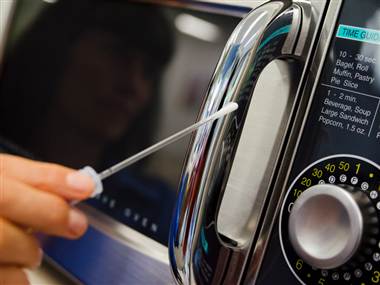Environmental Screening

Environmental PCR Testing
Many unseen things can be detected using today's powerful new tools for forensic testing, such as PCR.
Forensic techniques can be used to determine who licked the stamp on an envelope 50 years ago, for paternity
testing, diagnose infectious diseases, and environmental screening. DNA is extremely stable, and can be detected
long after the organism has entered the environment, even if it is no longer viable. A dry, sterile foam tipped swab
(Swab Kits are available for purchase in the Sample Collection Supplies section,
here) rubbed across areas to be tested will
collect DNA, which can then be detected to identified any potential problems, from bed bugs in the master bedroom
to Avian Polyomavirus in the nest box.
Testing is available to virtually anyone wishing to identify what is in his or her environment. Pet owners, homeowners, hobbyists and breeders, hotels, property managers, veterinarians, and others can all screen for a variety of pests and diseases with ease and minimal skill. Sampling requires no handling of animals or insects and is totally pain free!
Testing is available to virtually anyone wishing to identify what is in his or her environment. Pet owners, homeowners, hobbyists and breeders, hotels, property managers, veterinarians, and others can all screen for a variety of pests and diseases with ease and minimal skill. Sampling requires no handling of animals or insects and is totally pain free!
- Open only a single swab at a time for each test area or room.
- Rub the swab in the general or suspect area for testing (do not be afraid to get it too dirty or dusty).
- Place the swab back into individual protective holder or plastic bag and send to the lab.
Understanding Your Results
Real-time PCR results are reported from our laboratory as Positive, Low Level Positive, or Negative. A Positive
result indicates that the organism is present, due to the presence of the DNA. A Low Level Positive means that DNA
from the organism was detected, but there is very little of it there. A Negative result indicates that the organism
is NOT present in the tested area or room.
Why Use PCR tests for Environmental Screening?
Speed. Sampling the suspected areas can be performed in a matter of minutes using common sense and readily
available household items. The sample can be sent overnight to the laboratory and results obtained in as little
as 24 hours.
Cost. This inexpensive method of detection is significantly less than the cost of calling a pest control company to come out to examine the property or to have massive animal losses due to disease.
Accuracy. DNA testing is over 99.9% accurate! No other method can even come close every time.
Do it yourself. One of the best parts about DNA detection the ability to do it yourself. There are no additional costs, plus you can also be certain that all of the areas in question are examined discreetly and privately.
Peace of Mind. The #1 reason for DNA detection is peace of mind. Know for sure if you have a problem such as a bed bug infestation or if your pet is at risk from diseases in the environment.
Cost. This inexpensive method of detection is significantly less than the cost of calling a pest control company to come out to examine the property or to have massive animal losses due to disease.
Accuracy. DNA testing is over 99.9% accurate! No other method can even come close every time.
Do it yourself. One of the best parts about DNA detection the ability to do it yourself. There are no additional costs, plus you can also be certain that all of the areas in question are examined discreetly and privately.
Peace of Mind. The #1 reason for DNA detection is peace of mind. Know for sure if you have a problem such as a bed bug infestation or if your pet is at risk from diseases in the environment.